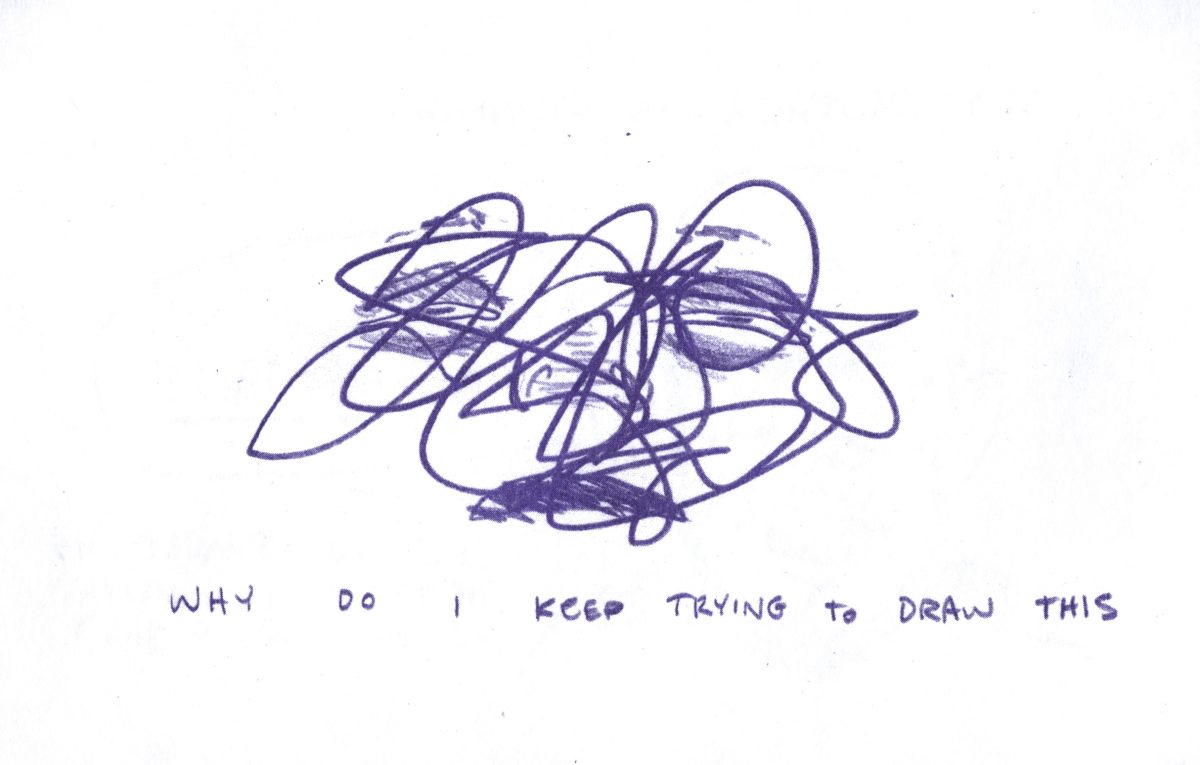
In October 1977, two days after his mother’s death, Roland Barthes wrote a note to himself on a scrap of paper: “In the sentence ‘She’s no longer suffering,’ to what, to whom, does ‘she’ refer? What does that present tense mean?”
Grief is an experience like few others in its capacity to render language useless; it ruptures our notion of time and defies our every effort to carve meaning from it. It is gdifficult to picture a year in which this has been made more painfully clear, both individually and collectively, than 2020.
After the sudden death of my dearest friend in November 2019, I spent a great deal of time immersing myself in art made from a place of bereavement, hoping I would find some type of solace from the disorientation and alienation of mourning. There were four cartoonists whose work I returned to time and again, and in September, we gathered virtually to talk about grief, comics, sex, the world we live in, and the many burning contradictions that come with trying to make art about something so fundamentally unbeautiful.
Carta Monir’s short, searing comics perfectly encapsulate the fraught nature of grief. Never simply an isolated event, they bleeds into and are inflamed by other traumas, histories, relationships, and identities. Frequently working with digital interfaces, memory, and reflection on her transition, her comics are unlike anything else I have read and are lodged deep in my mind. Tom Hart’s Rosalie Lightning is a beautiful, elegiac novel that chronicles grief’s impact on the linearity of everyday life, work, and financial struggle. Leela Corman’s We All Wish for Deadly Force anthologizes several nuanced pieces on the personal, neurological, and intergenerational realities of grief and post-traumatic stress disorder, all told in rich watercolors and threaded together by a sense of longing for her ancestors and the love and mourning they share across time. Anders Nilsen’s Don’t Go Where I Can’t Follow, a multimedia assemblage of photos, letters, diary entries, and comics from before and after his fiancée’s passing, overflows with care and tenderness. It’s a beautiful tribute to a shared life together, gently wedding the uncertainty, pain, and meaninglessness of death to the profound love that exists beneath and beyond it. The End gathers sketchbook and collage pieces drawn in the year that followed. In both hurriedly scrawled dialogues and finely textured scenes, it is remarkable in its synthesis of heartbreak, rage, confusion, and the knack for absurdity that Nilsen has become well-known for.
—Sage Clemmons
THE BELIEVER: Thanks so much everybody for being a part of this. I’m curious if you all have been drawing much lately, and how you’re doing in the quarantine and how that’s been affecting you.
LEELA CORMAN: I’m in the stage of my book where I have to do a bunch more writing. Also, I have a lot of painting to do. The only thing I was able to do was ink—just psychically, that was the only thing I could handle. Because of everything we’re collectively processing, I just felt like my circuits were fried. But working with color was doable. Trying to tell a story or deal with the logic of a 200 page book that’s a complete mess—I can’t right now.
TOM HART: I use art to ignore the rest of the world, so it’s been working out okay. [Laughter]
ANDERS NILSEN: I’ve been drawing quite a bit and organizing color and stuff for the next issue of my book, Tongues. I guess one way COVID-19 has impacted my work and my psychic life is doing a couple of pieces about it for magazines or newspapers. And that’s hard. [Laughter] Trying to figure out how I feel about it, sort of going back into this place of thinking about people being sick, and people dying and stuff. It feels like, “okay, maybe I have something to say about it, because of experiences that I’ve had.” But it’s also pretty heavy to go back there and try to remember how I feel about it.
CARTA MONIR: I’ve been in a real drawing slump. I haven’t done a lot. I think a lot of my creative energy has been directed elsewhere. This sounds like a joke but its not. I recently pivoted to making hardcore pornography and it uh, pays much better than comics. [Laughter]
LC: Yes!
CM: And honestly like, it feels so much more approachable to me. Even though it’s still a lot of work and there’s a lot of video editing and stuff. But I mean, given the choice between sitting down and drawing comics about sexual abuse or having sex with someone hot and filming it, the choice is easy. [Laughter]
BLVR: I saw you say something about how that makes you like, the reverse Chester Brown.
CM: Yeah, it’s because I’m funding my comics hobby through porn!
TH: Yeah, I learned that a couple weeks ago Carta. Because I was looking at some of your early comics about video games or something, trying to find the link, then I came running inside to Leela and I was like, “and then suddenly there’s this thing called OnlyFans! And then Carta was on it!” [Laughter]
CM: In a way, it feels like an extension of the practice I had started with Napkin, or other stuff because I was already doing a lot of very confessional work about my personal life and my sex life. I dont have anything to hide or whatever, so making straightforward pornography didnt feel that different to me, you know? I’ve already alienated everybody that would be offended by it.
LC: And anyone who’s going to be offended by that, just fuck them.
AN: That’s interesting that there’s a parallel there, that the talking about loss or grief or stuff like that is a little bit uncomfortable. Are you saying it’s uncomfortable in a similar way?
CM: I think when you’re making work that feels risky because of how vulnerable you are, and you’re not sugarcoating yourself or your own reactions—and in my own case I had been making work about sex and my body and transition and all these things, so it felt like all of this stuff was in the world already. I had already talked at length about getting an orchiectomy or the way that it feels different to have sex now or whatever. It didn’t feel like I was exposing myself anymore. In fact, it feels easier, because it’s not emotionally vulnerable in the same way.
BLVR: That makes me think of when you were here in White River and read a passage from David Wojnarowicz’s writing, and his work is so equally split between talking about collective loss, illness, and grieving, and his sex life.
CM: Yeah. I really like a lot of gay writers and artists from the ‘70s and ‘80s or, specifically, works from the ‘70s and ‘80s where there’s this sort of parallel between writing about loss and also celebrating what they had. There’s so much work that was published in the ‘80s that’s like, “Remember the ‘70s? Remember when you could just go to a truck stop and fuck a guy? We can’t do that anymore, but we’re celebrating it still, and this is what we want to return to.”
AN: David Wojnarowicz was super important to me when I was in high school and the way that sex and death and love and transgression is all a big mash in his work.
CM: Yeah, absolutely. I think when I was at CCS I read the passage that ends with, “And if in that moment I had a gun, and a police car had driven by, I would not have hesitated to open fire.” And it’s a passage where he’s describing giving a guy a blow job in a hot car. Beautiful!
LC: I feel like I’ve been getting back into a lot of stuff from that same era, but the women’s writings and art from that time. The way I described the pandemic at the beginning was, “I want godless things right now.” Which is a weird thing for me to say, because I’ve never been religious so the concept of being godless doesn’t have a lot of weight, but I think culturally it does. So I feel like I want to claw my way back to that kind of visceral, unapologetic, confrontational art that raised me. I don’t think this is a time for any of us to be whispering.
CM: I agree, especially in an era where I think there’s still this holdover impulse to uncover evil and uncover corruption. But like, we live in an era where everything is on the surface. We have 20 Watergates a day; nobody’s hiding it. And there’s not a secret, underlying plot. It’s just out in the open, they just say what they’re doing. And so I think art also needs to be confrontational in that way. Not like, “But what’s the big conspiracy that ties this all together?” as much as, “Fuck you!” We’re alive and we’re very angry and we’re doing fucked up shit and we’re pushing back against this.
LC: Yeah, we fucking see you! But we’re going to be seen too.
CM: Right, exactly.
LC: I’ve been working on a book about World War II, like, a very quiet, ghostly, haunted book about the Holocaust. I started it before 2016, before the election, and so now I’m like, “Great, now I’m just drawing pictures of corpses, this was already taxing.”
CM: That sounds totally brutal. I don’t know how you can sit down and do it.
BLVR: When I was rereading We All Wish For Deadly Force, I was really struck by the comic that you made about the Eames chair, and the legacy of design and aesthetics from your grandparents and the generations before you. And how the aesthetics that were being created were very much about imagining a future, and shaping the way that we think about the world, which seems relevant as well.
LC: Yeah, I think about that a lot. I think about modernism a lot in that context, in that it inevitably leads me back to the Nazis shutting down the Bauhaus, and all the various directions the different Bauhaus artists went. I mean, to bring it back to the now, I don’t know about the rest of you, but one of the hardest things [about the pandemic has been] not being able to envision the future. And not even the recent past either, just like this day-in, day-out cycle of rage and staying away from other people and, you know, all these weird internal experiences of the external, if that makes sense. The future is just foggy.
AN: I feel like that’s something that working through work about grief made very clear to me, was that really the hardest part was losing your future.
LC: I read an interview with some quote from a woman who lost a child, kind of in the year after we lost our first child, who said that the experience for her was like being on a train speeding in one direction, and then all of a sudden being on the train speeding in the other direction. That felt really accurate. I will say, I feel like hardcore grief taught me how to go into quarantine, just submit to it. Like, now I know how to withdraw from society completely.
CM: Yeah, I mean I assume that this is similar for the rest of you but at this point, when something like quarantine happens, I definitely have this feeling of, “Oh it could be so much worse!”
LC: That’s a survivor’s statement I think. I feel like that got passed down to me from my own family—yeah, of course it could be worse!
BLVR: At the risk of overusing the phrase, “this moment in time” or “this experience” and what-have-you—it’s made me think about making work during your loved one’s illnesses, as opposed to afterwards. I’d imagine that puts a really terrible pressure on trying to figure out what to capture and what is important. And I’m curious, perhaps specifically with your experiences Carta and Anders, if that question, or pressure or mentality, has affected the way you approach your work now.
AN: When Cheryl was sick I wasn’t really making work about that other than a few times in the hospital, when I would draw her when she was asleep or whatever, and journal. I guess that’s making work about it. I don’t know if that’s influenced how I make work now. I don’t super get that question. Carta, do you have anything to say?
CM: I mean, I was trying to make work about it when it was happening but it was hard to feel like I was able to capture anything accurately. Like honestly, being a few years out and forgetting a lot has helped because now I know what to prioritize. You know? Like I look at my notes, I took a lot of notes at the time, and there’s a lot of stuff I just don’t remember until I’m looking at them. I was so scared of that happening in the moment, and it became impossible for me to tell what was the most important thing or the thing that I wanted to capture because, you know, storytelling is about making narrative choices. And so now that the experience has sort of formed a more concrete shape in my mind, it feels easier to approach it and think about building it into something that has more discrete parts instead of just being a stream of like, everything I can think of all the time. But I don’t know! I find it very difficult to sit down and make work about it because I still get overwhelmed.
I’m working on a comic right now that’s several months overdue, and I’m working on a book that’s several years overdue. And in both cases I have very understanding editors and there’s not a ton of pressure, but it still just overloads my brain a little bit to sit down and try and think about.
BLVR: Yeah, I feel like an overwhelming part of making work about grief is trying to deal with the way that there’s no story to be made out of it or nothing to be learned from it. Like you were mentioning earlier, the loss of the ability to imagine a future. There’s a loss of cohesiveness and even memories just being completely blocked out. I hadn’t ever thought that the loss of memory could be a good thing or a helpful thing in any way.
CM: I mean, it’s really scary. One of the first works I made in which I depicted my mother on her deathbed was the one for Zainab’s anthology that I called RIPMOM, where I made a 3D model of my mom’s head.
BLVR: And the file is degrading every time you open it.
CM: Right, and that comic was entirely about how terrified I was of forgetting things, and how obsessed I became with the idea that every time you remember something you’re putting on a play of the memory in your head. So, each time you do it, it becomes degraded in a way, or like one step removed from the actual experience. And at this point—I mean, it’s been nearly four years—it’s impossible for that not to have happened. The memories have streamlined. And it’s just something I’ve had to learn to live with. I don’t remember the exact layout of every room anymore.
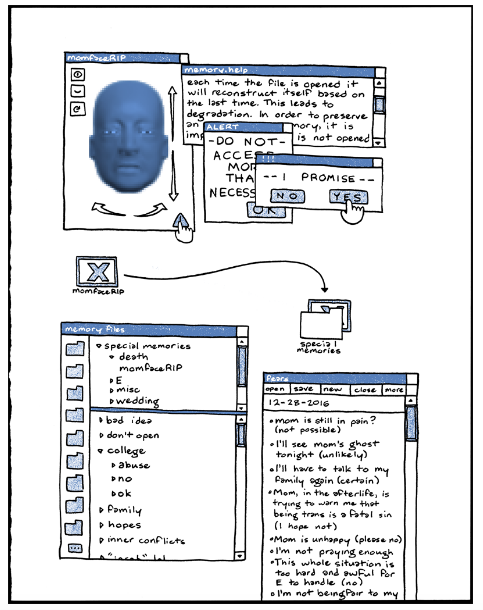
Something I think about a lot that gives me comfort is that Phoebe Gloeckner will tell the same story like three times, over three different comics, and all the details will be different. Someone different will be saying a line, or it will happen in a different context, or things will happen in a different order. And that gives me a lot of comfort because nobody looks at Phoebe’s work and goes, “Well you fucking liar!” There’s an understanding that she’s working with the mutability of memory and that’s something that I’m trying to lean into more and more—this understanding that my own experiences are not perfect. The only thing I can communicate is what I remember, as best I can. And nobody is holding that up and saying, “This is a perfect unaltered truth of everything that happened here.”
AN: Yeah, that there is no actual truth. You can’t hold onto the perfect facts. It’s like, after an event like that leaves your life in tatters, repeatedly telling the story is part of how you get over it or get past it. Choosing the parts to pay attention to and turning it into a structure with a beginning, a middle and an end—that’s how our brains work. We have to do that to make the world make sense. And it’s like, if it’s kind of a little bit of a lie—
CM: It has to be!
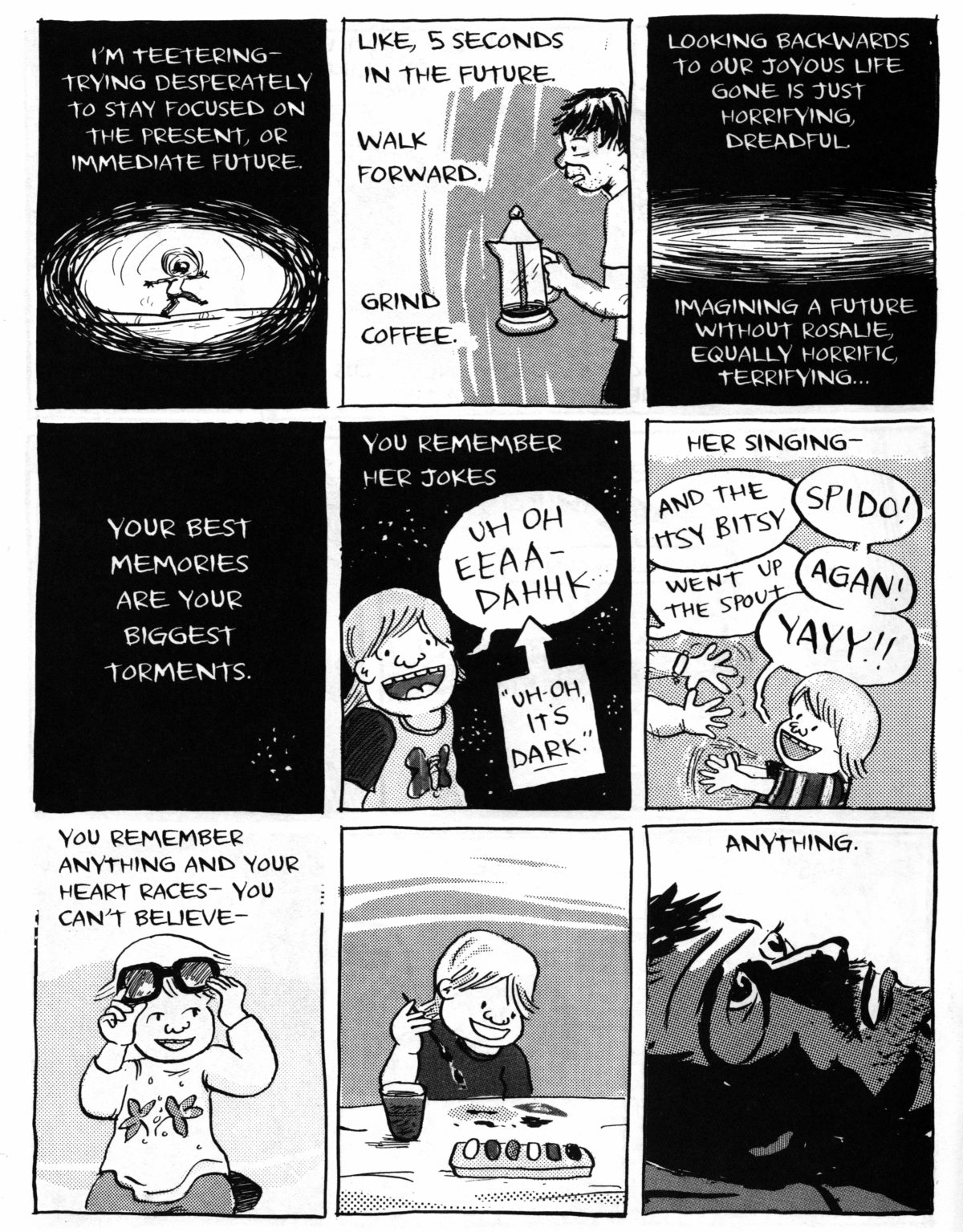
AN: That’s just how it works, yeah.
AN: I’ve actually been reading this book right now about trauma, and there’s a part in there about unaltered memories. Like, experiences of trauma leave you with unaltered memories. You actually have these images that are intrusive that you can’t get rid of. And actual normal memory is always partially made up.
LC: I don’t know about the rest of you, but I feel like the comics that I’ve made that directly address my own trauma were definitely that. I wasn’t trying to make a map. I mean, I wouldn’t call the process of editing even a lie, as much as just a filtration. You’re choosing what to prioritize, creating this structure around it. You can’t give the reader everything of your experience unfortunately. The science fiction concept of the mind meld is so great; I wish I could do that, though I don’t want to hurt people with those memories. But if I could transmit things that are not visual, things that are physiological, in my comics, like the sound in my head when something was happening, or the adrenaline. If I knew how to do that I would! But I can’t. So that’s part of the construction too.
BLVR: Definitely. I was really struck when reading your comics, Leela and Carta, in thinking about dissociative responses to trauma or dysphoria, or other situations of total overwhelm. It’s interesting because drawing an experience is both a way to re-embody it but also like, the ultimate way to be separated from your body. So I’m curious how that has been.
LC: Yeah, I think that we are overly invested, in this culture, in linear communication. And so, so much of what we are doing is nonlinear, even if we’re telling a relatively linear narrative, even if we’re using the tools of realism to tell a story. When I was doing the comic, that really was exposure therapy for me, which was the PTSD piece that ran in Nautilus magazine. That piece changed my entire artistic trajectory and my career. The whole time I was working on it I was listening to an album called Lament by Einstürzende Neubauten, which is a commissioned piece about the first World War. I was listening to this very nonlinear approach to a massive collective trauma to the species, while I was trying to be kind of linear. I was trying to talk about the science of trauma of what happens in your biochemistry.
What I discovered in that piece is that the more you try to talk about trauma and describe it, the less describable it becomes. It becomes bigger and bigger, like the folk tale about the fish that gets bigger the more you try to catch it. So part of the joy in making that piece was to let go of trying to describe it so much as just trying to make an immersive experience out of my trauma for the reader.
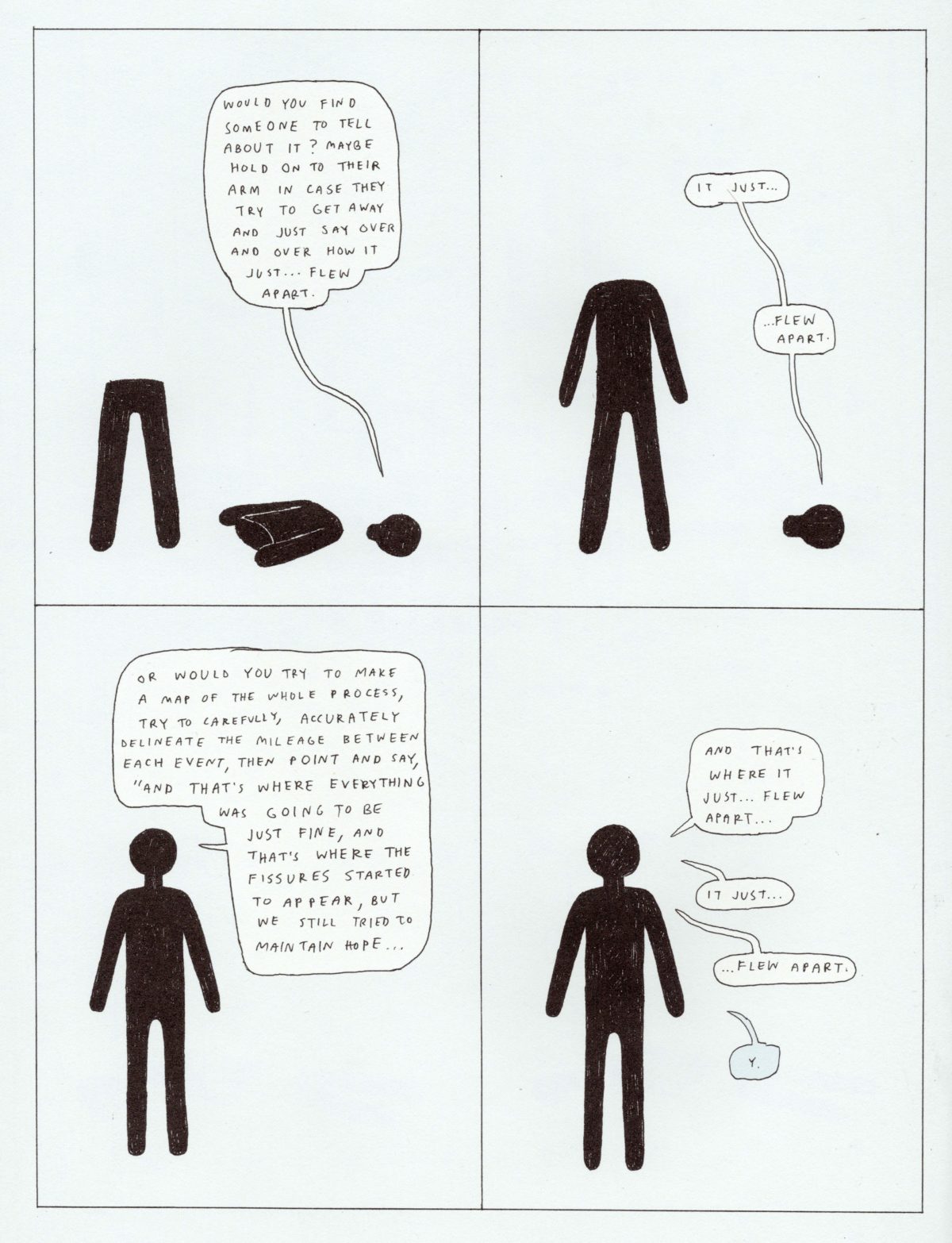
CM: Yeah, absolutely. In terms of depicting trauma, I totally agree with you, Leela. You know, for me, I think drawing myself a little slack-jawed with a spiral next to my head is probably a more effective depiction of trauma than writing out anything. Because at a certain point you just can’t communicate it. Like as much as you type, “I felt empty. I didn’t know what to do. Food didn’t taste right,” or whatever, it’s just hard to communicate that. And I think it’s better to let the reader kind of embody the experience as much as possible, which is where the confessional aspect really comes in. Like, the more detail you can give, and the more that you are willing to make yourself vulnerable, the more the reader is able to empathize. I mean, I think a perfect example of that type of work is Debbie Drechsler’s Daddy’s Girl. Which is a book I find difficult to recommend to people, because it is truly unpleasant to read. Like, a deeply, deeply unpleasant book to read, but that’s the point, you know? There are hardly any balloons in that book. Like it’s not about the internal experience of any of the characters, so much as just showing what happens and letting you infer a lot about mental states through facial expressions and through your own experiences. And that book devastates me. I think it does a really effective job of depicting trauma without needing to over-explain. It doesn’t need footnotes or whatever.
LC: I think that there needs to be a little bit of mercilessness in these things that we make. But perhaps that’s unkind of me!
AN: I think that was definitely part of what made it possible for me to do Don’t Go Where I Can’t Follow, and probably The End a little bit. Like, after going through that experience, with apologies, I didn’t give a shit what anybody thought, you know?
CM: Right.
AN: And I sort of wanted to punish the rest of the world for what had happened to me. So it was sort of like, yeah, this is what it is, and if you don’t want to read this book, then go to hell or whatever.
TH: If you don’t mind, I’ll be the one person who didn’t have that experience. When I was making my book, the early iterations of it were furious and ugly and at some point, I didn’t want to draw. And I realized, “Oh I’m just drawing all these cruel, horrible things, and I’m trying to punish the reader by making them feel as bad as I did.” I needed to get to a new place in my body and my experience that was not an angry, hateful, horrible place. I’m not going to make that book. That was a very conscious. That was like the major shift in my process at a certain point. Where I realized, this has to be a book about more than pain.
AN: Right. I didn’t want the book to be that, but that was what allowed me to really be honest or even put the work out there. And then when I lost that, after like six months or a year, I looked at that book and I was like, “Oh, Jesus, what did I do?” [Laughter]
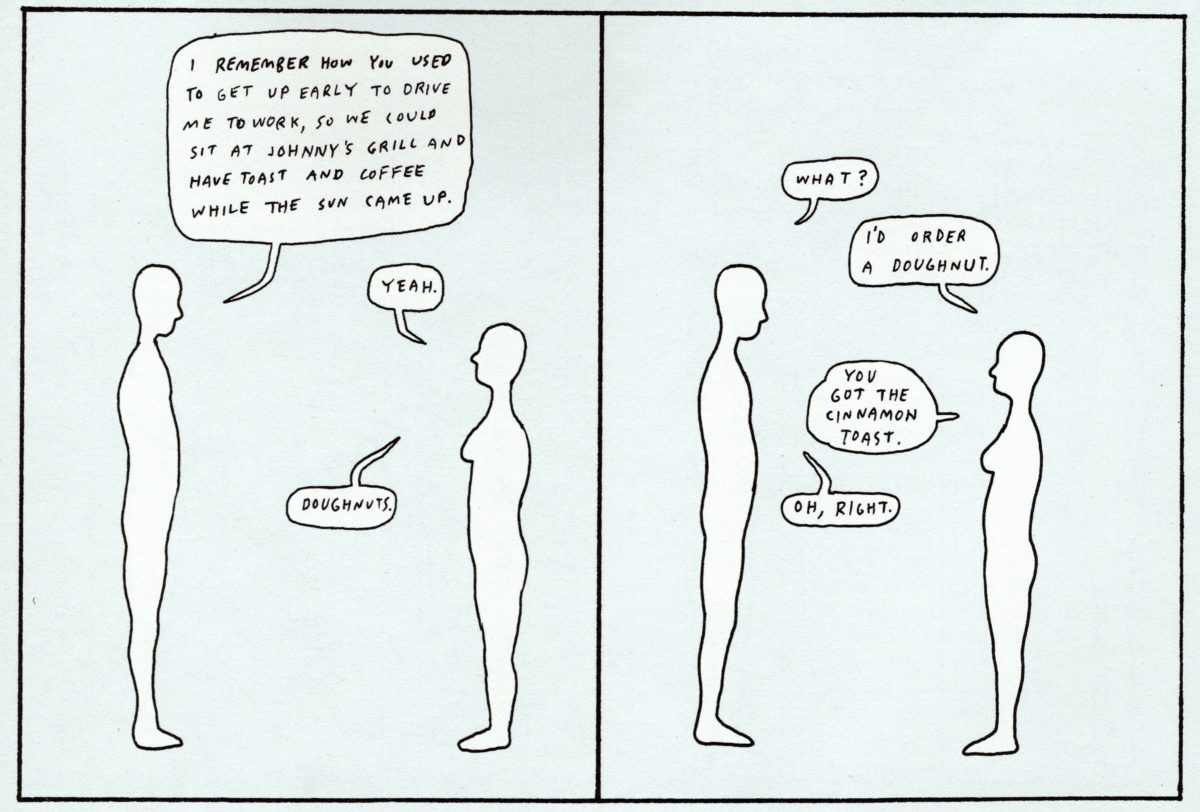
LC: Yeah, when I say merciless, I don’t necessarily mean cruel or angry either. I’m sorry I keep bringing up this album! But I was reading an interview with Blixa Bargeld where he was talking about making Lament and he said, “I wanted to tell horrible stories beautifully, not the other way around.” And that became my motto. I think that’s still my motto. There’s that intersection of beauty and brutality where all this work lives.
CM: I think a little bit of humor with the brutality too, because something that stands out to me in work about trauma are those human moments where you kind of notice something that sticks into your mind. I know that in my own experience, like when my mother died my brother shouted and wailed, and what I remember about that very vividly is like, “He’s being so loud! He’s being kind of rude, honestly! I wish he’d quiet down a little bit!” Or, “Jeez the hospice people have an interesting job! They must say this all the time! I wonder if it’s rude or weird to tip a hospice worker?” [Laughter]
I think that’s a very important thing to include in that kind of work as well, because in those moments when you’re traumatized or kind of dissociating or whatever, you’re not only thinking dark, cloudy, bad thoughts. Like, your brain goes everywhere!
AN: Yeah, I think tragedy and absurdity are very closely entwined. I was constantly aware of that, being in a public place and dissolving into tears, and sort of watching myself from above. Like, this is ridiculous, why can’t this person get their shit together?
BLVR: Definitely. With regards to how you wanted your books to be received and experienced, I’m curious what it’s been like in terms of the reception to your book that did happen.
AN: For me, the reception to Don’t Go was weird. Like I said, by the time the book actually came out it felt really awkward to me, and I felt like I was exposed too much a little bit. I did end up letting it go out of print. It probably got more attention than anything else I’d done, and I was a little wary of that becoming my artistic identity. But then as time went by, I did get some people writing to me about it. You know, with work that is vulnerable or whatever, I think people do relate to it and it actually is useful to people. And I guess that’s why I ended up reprinting and sort of deciding, “Okay, these books have a place in the world even if I’m a little uncomfortable with them. I have to honor the fact that somebody is getting something out of this”.
LC: For me, it happens in the context of teaching sometimes. When I’m teaching workshops to university students, I’m talking about that. I’m talking about trauma and I’m having them tell personal stories. I’m not making them focus on trauma, I’m talking about, “This is my own experience.” And I always end up feeling like this bat descending from the rafters. Like, “Let me tell you children about the future, all of you will experience something terrible! And that’s just normal! You get to a certain age and people you love have died!” I’ll use one story to illustrate it, because it kind of blew my mind. I was in Connecticut, teaching a workshop and this guy that had been so quiet during the workshop that I didn’t even really notice him waited until everybody left and then he came up to me. And he told me that he was a veteran, two tours in Afghanistan, and did not like to talk about his PTSD but he wanted to show me the comic he was making about it and it was amazing. It was beautifully drawn, it was really smartly told, and I was like, “You have to publish this, this is really beautiful!” And you know we just stood there talking for like an hour, he just opened up! So, I think that if you have the capacity to talk about whatever your bad experiences were, even if it feels vulnerable and exposing, if you have that ability I feel a sense of responsibility to it, and part of that also might come from my own family background. My family were Holocaust survivors who were completely stoic and locked down, like, almost catatonic about what happened to them. So I’m not like that! [Laughter] So I feel like it allows other people a release valve if someone can tell that story.
AN: When I put those books out, I didn’t really do any readings or book release things. Like, I did not want to go back and, on the one hand, stand there and talk about it and sort of revisit it myself for an hour, and then, yeah, the interactions can be very awkward. It’s like people think they need to console you, you know? Like, strangers will want to console you for something that happened five years in the past.
I did do a workshop one time for people that had experienced loss, and it was weird. I felt like what you were talking about, the bat descending from the rafters. I mean. I did not feel qualified. I think for some people it was actually really helpful, but there was one person in particular that I remember, where the exercise had clearly brought up some really heavy, difficult, ugly stuff and I was just like, “I’m going to do my best.” I’d like to think I helped. I’m not a therapist, therapists get training for this. I’m a cartoonist. [Laughter]
CM: I’ve done a few workshops about making work about trauma and also making work about like, sex. And in both cases I think the technique I try and use is to make the actual exercise very, very open-ended, and also pretty mild. Like, my goal is usually to get people thinking about it, and to sort of prove to themselves that they can make work about something. But I don’t want them opening their worst possible thoughts or whatever right there, because it’s usually a short workshop and there’s usually enough people that there’s no personalized time. So in workshops like that, I’ll usually give a prompt that’s like, “Make a comic about something that would make your mother uncomfortable to read.” And that’s very open-ended, you know.
AN: Mothers can be made uncomfortable by all sorts of things.
CM: Yeah, and in terms of personal reactions, I’m in a similar situation to you, Leela. In that the work that I have out in the world is short form, but generally it’s why if anyone tries to find me at a convention I’m often up walking around. Because I love seeing people and I love talking to people, and people do often come up and tell me about how my work has impacted them, or about their own experience and how it relates. And I can do some of that, but then I get very tired very quickly. All of us make comics because it’s a way of delivering information without having to see the other person receive it, you know?
LC: Yeah! Except in very controlled ways that you get paid for! [Laughter]
CM: Yeah! I made the mistake of doing a reading of one of my intense comics early on and what I learned from that is, people act as if the thing that you’re describing has just happened right now in front of them. And they want to come up and talk to you about it as if you must be just reeling from this thing that just happened and you end up having to comfort them! You know?
AN: Like, reassure them that you’re okay.
CM: Right, yeah!
BLVR:: I’m curious how —or if—you had a conscious thought about when to stop in terms of what to include or how to assemble the comics you have made. Like I know Don’t Go Where I Can’t Follow had sort of a specific theme of travel and trips and correspondence, but maybe, when grief is in some ways something that never ends, how does it feel putting it into a finite object?
AN: Well for me, in November it will be fifteen years, and it’s definitely something I still think about. I’m supposed to be working on a re-release of The End right now. I think that having this conversation coming up, and reading this book on trauma that I’m reading right now gets me thinking about things like, “What else is there to say?” It feels like there is other stuff to say. I don’t know if that’s where I want to put my energy or not, but for the two books that I did, I think they just sort of ran their course. There were time constraints I guess, and I think the drive at the time, the thing that made it feel imperative to do them, petered out after a little while. Like, it was the thing I was just driven to work on for about a year afterwards, a little over maybe. And then at a certain point it was like, “Okay, I need my brain to be able to go to other places. I mean I remember a moment, probably a little over a year after Cheryl died, being in an airport after a book tour or something, and doing a funny comic for the first time. Just drawing in my sketchbook and coming up with something that was funny just to be funny. And thinking “Oh, wow, I just crossed over a threshold here. I couldn’t have done this a week ago.”
LC: That must have felt good.
AN: Yeah, I remember it feeling good. And a month before, it would have felt like a betrayal.
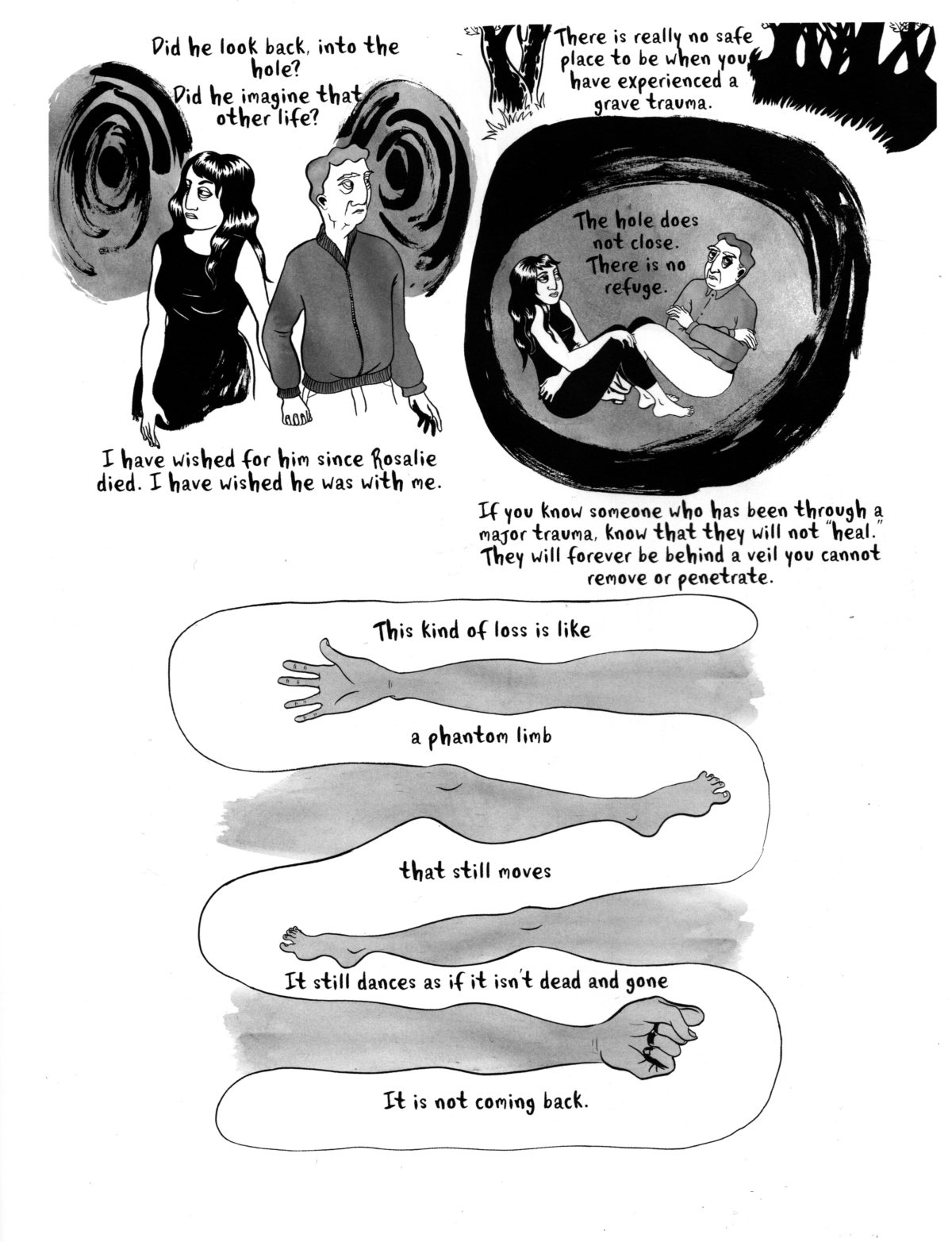
LC: I think for me, I’ve always been very into emotionally heavy art anyway. I like heavy music and I’m kind of an expressionist with capital E, so I gravitate toward that stuff in other people’s work as well. There have been moments where, in my own work before and after, any work I’ve done, I feel like, “Oh, I probably went a little too far with that.” [Laughter] Like I pushed that joke a little too far or showed a little too much, or was a little vulgar or a little gross.
AN: Can I just pause there? “Oh I went too far, therefore…” Or? What’s your next thought?
LC: That’s a great question. I do shoot for a kind of elegance and refinement in the merciless department. Like I’d rather have a little bit of elegance and not be completely obsessed with making something that’s like, “Are you freaked out yet? Are you freaked out yet?” So, my next thought is usually, I wait and see how it affects my body. If I have a visceral reaction to something I made, if something that I made makes me tear up or makes my teeth clench or gives me this kind of solar plexus type punch, I leave it in. I guess what I’m trying to say is that for me, I don’t worry so much about going too far in terms of being vulnerable or intense. What I try to avoid is being overly dour. I don’t think it’s necessary for me. I don’t judge anybody for it, it’s what I try to avoid.
AN: I can relate to that. I mean, I like some work that’s like that. But it does feel, for me as an artist and for a lot of the work that I like, it feels a little dishonest. It kind of goes back to that idea of tragedy and absurdity. Like, life isn’t just tragedy, and if you go in super heavy in one emotional register, you’re sort of eliding the fact that there are other emotional registers that impinge and come in whether you like it or not.
TH: Yeah, I think I had all the dark, angry, ugly sort of stuff and every once in a while, I find the notebook that I kept from that period and flip through it. I’m about ready to make it disappear, but every once in a while I’ll just see a couple of lines of text or something and I get that sort of solar plexus thing you’re talking about. It’s the stuff I edited the first time and maybe it can go somewhere later.
LC: Well, there’s a use for it!
CM: I think part of the reason I’ve been working short form so much is that I find that my work is a lot better when I focus on one thing. Otherwise, I definitely have what I would call “the beginner storyteller’s impulse,” which is to start the book with the beginning of the universe and end with the end of the universe, and include everything in between. For the bigger project I’m working on, the question I asked myself was, “How far do I need to go back in order to explain the threads that are most important to me?” So, in this case, I picked a point a couple years before my mom died and then am ending it shortly after. Not to bring up Phoebe all the time, but something Phoebe will do is she will literally put in like, a little row of panels underneath something with background information. She introduces a character and just has 3 or 4 panels that tell you everything you need to know about this character real quick, and I think that’s great, you know? Like, you don’t need more than that always. So, that’s at least what I’m trying to do. But short form is easier because generally, when I’m writing and something isn’t working, the answer is I need to remove scope or detail and focus on one thing, and that’s what makes my work good. Like, that’s what makes it feel good to me. So short form is easier in that sense, because you can really choose one experience or one aspect of something and narrow in on it.
LC: Bring up Phoebe all the time! It’s good to keep bringing her up in this context, because I always think about Nightmare on Polk Street while I’m writing. I think about Phoebe and Debbie but especially Phoebe. When I was first making comics and I encountered her work, that was like the lodestone. The thing that told me you can say anything and you can push things really far in this medium. You can be merciless in your storytelling, she taught me that.
CM: Yes. I think for me the trinity is Phoebe, Debbie Dreschler, and Genvieve Castree. With Susceptible, oh my God it’s so good. Those are the three books that I look at and I think, “This is everything that I want to do.” You know?
BLVR:: Anders, you were friends with Genvieve, right?
AN: Yeah, I would back anybody that wants to put her in their Top Three.
CM: Have all of you read Charlotte Salomon’s work?
BLVR: Oh my god, hell yes.
CM: I highly, highly recommend it. She died in a concentration camp at the age of 26, she has an enormous body of work that when assembled constitutes what I would call a graphic memoir. And its about trauma and the Holocaust, and childhood sexual abuse, and the death of her mother, and it is just absurdly moving and beautiful and should be part of our canon as much as any early cartoonist.
LC: I have that book sitting on our kitchen table right now.
TH: I think I moved it.
LC: Okay. [Laughter]
There’s so much work from that time period that isn’t well known and I think Charlotte Salomon’s work was kind of rescued from obscurity.
CM: Yeah, absolutely. Along similar lines, Mine Okubo’s Citizen 13660 is an illustrated memoir about her time in a Japanese internment camp in California. I would call it comics adjacent; it’s just some of the most amazing work, really, really incredible. And I was not aware of it until Kris Mukai mentioned it at some point.
LC: I went to the museum of contemporary art in Krakow last year, and there were two exhibitions of art related to the second World War, made from the 1930s up to now. Mostly from eastern Europe, almost entirely stuff I had never seen. Paintings, prints, ephemera, propaganda, these incredible photos of the Warsaw uprising, and the larger uprising in the entire city. This woman had taken all these beautiful Agfa color prints and then died of a shrapnel wound, so there was just this selection of her prints. Just tons of narrative comic-related works by lots of people from the time period and after. As cartoonists, I feel like this stuff needs to be brought more into our line of vision.
BLVR: Yeah, I feel like that’s something that’s true of David Wojnarowicz as well, in terms of the things that we want to be the case when we make work about grief and trauma. When I think about his work, I tend to primarily be thinking not even of his gallery work or films but just the massive compendium of his diaries. I think he was a really beautiful example of integrating so many parts of his life in a way that becomes more than the sum of its parts, or something like that.
AN: Stumbling upon his work as a high school kid was bananas-revelatory to me. The way he…you know? I don’t even know how to describe it exactly. I was this young, sort of confused punk kid, very political, very into art, and he just mashed all this stuff together. Like, he was super political but completely non dogmatic in any way. It was all about his life: Sex and love and his biography and how these structures actually impinged on him and his psychic life. And he was sort of telling stories but it was super oblique at the same time.
BLVR: My last question may be redundant now but I’m still curious. Do any of you still make comics or drawings or anything about the people you have lost?
LC: I feel like I’m about to. I mean, it hangs over everything I do. But the long form work I do is fiction, so it’s more for me. I think I’m starting to work through more macro losses for me. Like loss of a culture, inheritance of genocide, in my work. The project that I’m starting to focus my energy toward is the next one, half of it is set in Poland during the war, as I’m thinking about it now. And dealing with having a connection to where my ancestors are from from being severed and then reconnecting with it recently. But I think that the people will come back in their own ways. I don’t think I will make a comic about my deceased child again. That’s a tender spot for me. I don’t really want to make comics about losing children, and I don’t really want to read books about it by other people, either prose, comics, or whatever. I shy away from that. There are some stories from my own family’s experience about that, so I shy away from the edge of that sometimes. Talking about my own experience in nonfiction is a lot easier. I think the person who keeps coming back into my work is my Yiddish grandfather, Mendel. I’m not traumatized over his death, I just wish I could talk to him. But he keeps coming back in because he’s kind of mysterious to me.
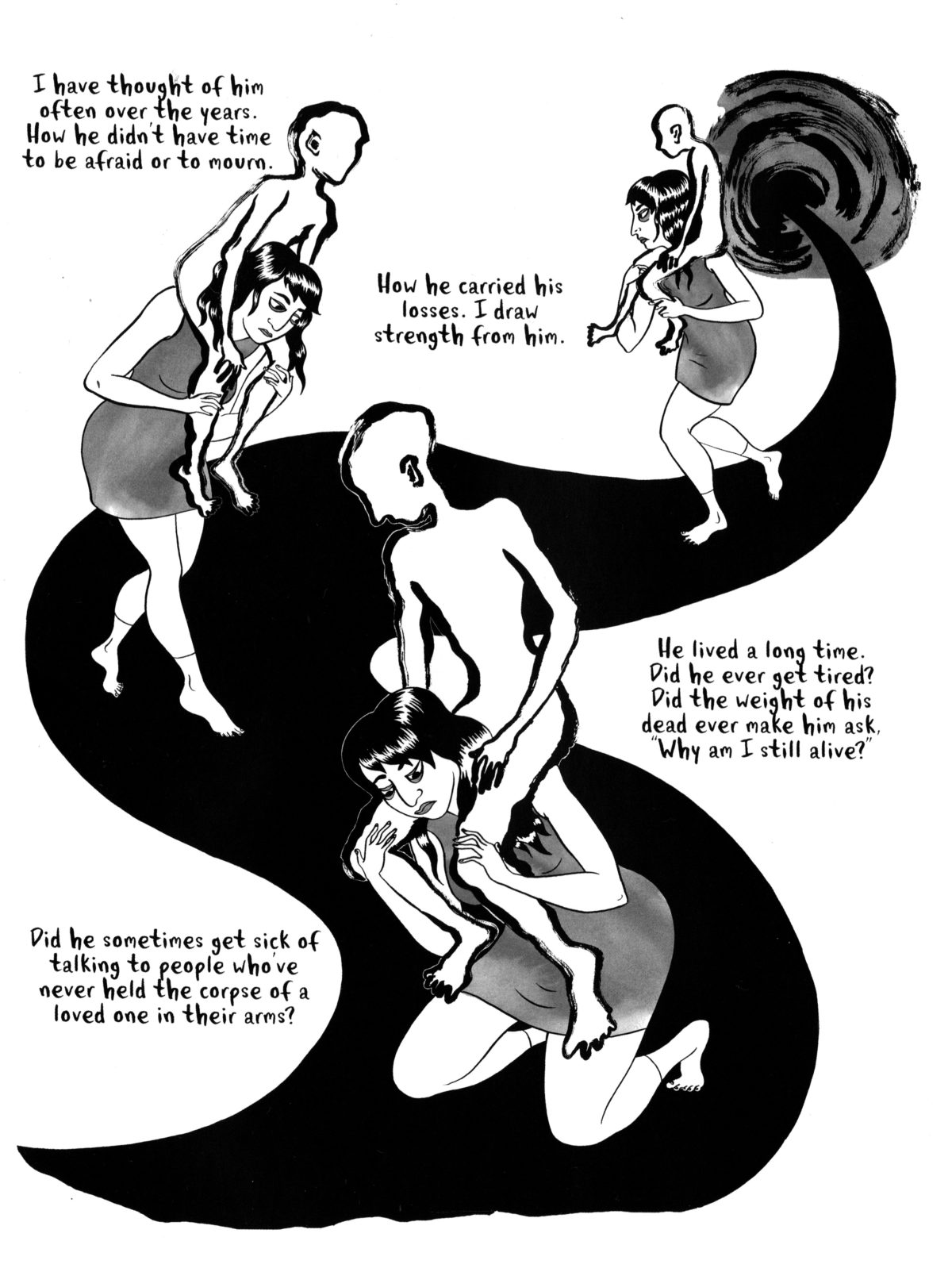
TH: You guys all saw our daughter Molly Rose pop into the picture a bunch. She’s processing having a sister and not having a sister, and that’s a pretty hardcore loss. So I think that’s where a lot of our energy is going in that regard.
LC: Yeah, right now she’s pretending to have multiple sisters. And for a long time she talked about Rosalie like she was alive with her. Then that turned into a bunch of—I don’t like to call those imaginary friends but, discarnate, not-people friends, sisters.
TH: She would even tell people on Zoom. She would say, I’m playing Rosalie, except her name is this, and my name is that.
LC: Yeah, which is completely confusing for anybody but us, but we believe in her internal logic.
CM: Yeah.
AN: I think I mentioned earlier, like the idea of doing more work about Cheryl is always there. Just recently I thought maybe, I don’t know, that I would start working on something like a book or a story. But just journaling or doing sketchbook stuff. Seeing if there is something there. I think most deaths are much more complicated than just a loss. There’s a part of me that would like to explore other things, and some of the complications made memories foggy, and I want my memories back a little bit. So there’s a part of me that would like to go back to that place. I don’t know if I will or not but it’s a thing I think about.
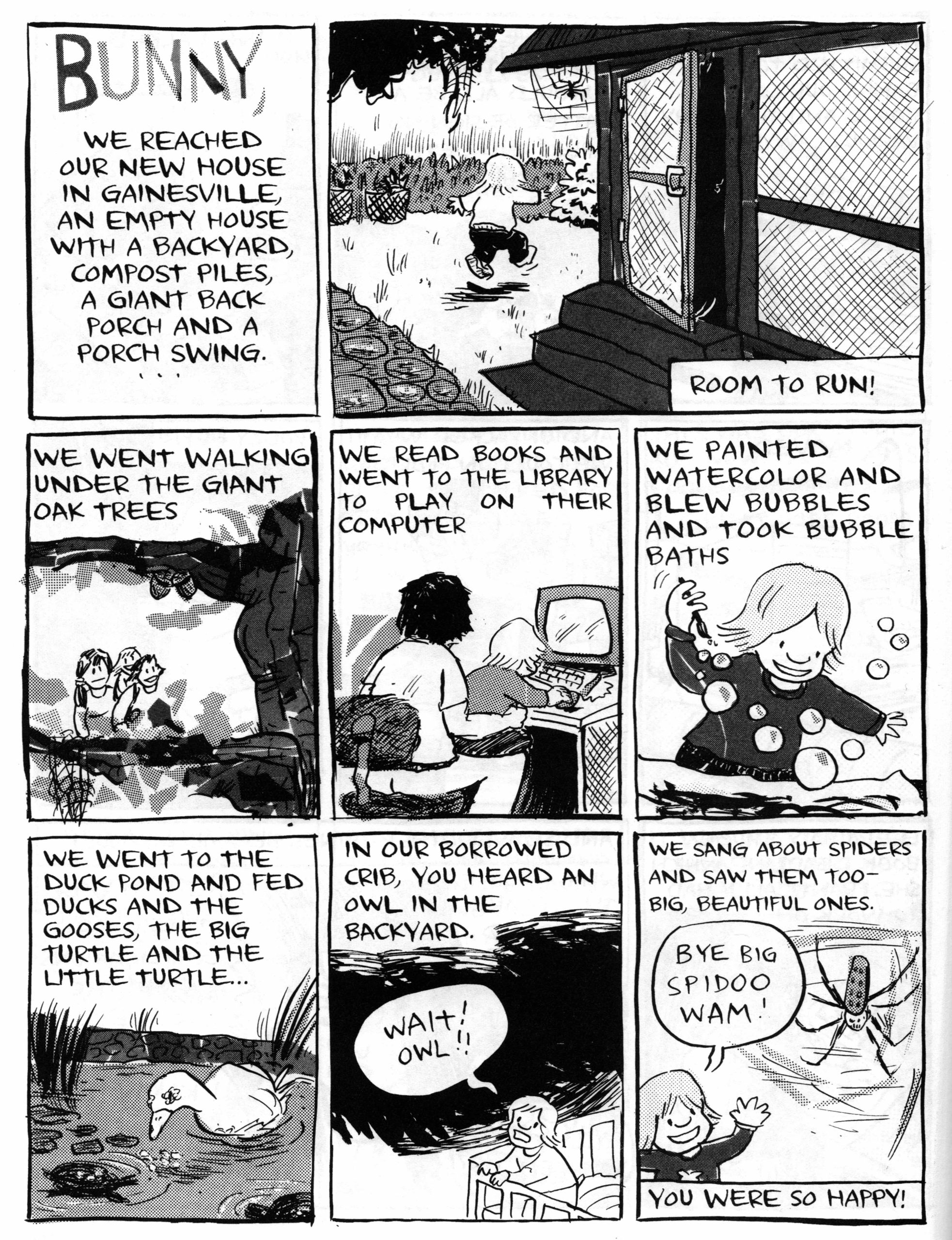
CM: I guess like, I’m still very much in-progress with talking about a lot of that stuff. I don’t know, I’m really glad that I’ve had such a big detour in my work, because it’s nice to be doing something that’s not just like, “I’m this sad person. I only make sad work about the sad things that happened in my sad life.” Like, it’s fun to make stuff that’s celebratory and sexy and engaging in ways that isn’t just on a trauma level. But I’m definitely going to make more work about it. It just feels like there’s too much still left unsaid. And it feels like if I’m going to try to write fiction, it’s just going to be kind of a clumsily disguised memoir. I’m just not very good at that! I’m better at just being direct. I think the hardest thing for me in writing about my mother and the circumstances around her death is that I think she would hate it. I think she would really, really not like it. And she explicitly asked me not to cut off my dad and not to say anything bad about him. And all of those things are promises that I have broken. And that’s really difficult and painful, and it’s something that I grapple with every time I approach this kind of storytelling. Finding a balance of talking about what’s true and what my own experiences are without, I don’t know, without feeling like I’m betraying her in some way or hurting her feelings in some way.
BLVR: Yeah, or overexposing things she would want to be private.
CM: Right, exactly. And so much of illness and death is loss of privacy, you know? And it’s important for me to capture that while at the same time not going so overboard.
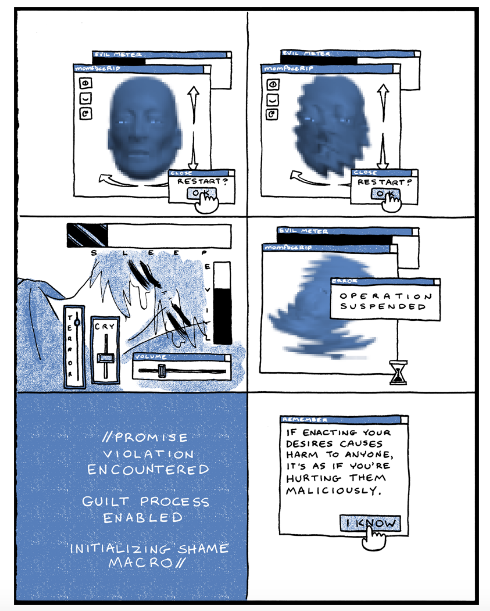
AN: When you say loss of privacy, what do you mean exactly?
CM: My mother was a very private person. She didn’t like to get dressed if her door wasn’t closed, even if there weren’t people around or whatever. But when she was dying of cancer, so much of her autonomy was lost. And her ability to say no to things, and especially to my father, disappeared. And suddenly all these things that were deeply private and personal about her life were out in the open for everybody walking through our door to see. And that was really difficult for her, as an adjustment, and something that was really difficult for me as someone who wanted to honor her privacy, even after she had died.
AN: Right.
CM: And so there’s still a challenge in depicting that, because I don’t want to overstep her modesty, but at the same time I want to talk about these things in a way that feels truthful and accurate to my experiences with them.
LC: This has been a shot in the arm, to be in the presence of other cartoonists and hear you guys talk, and thinking about these things feels really good after the last six months of just being in a hole. Be safe everyone!
BLVR: Yes, thank you so much, everyone. I think for me, as someone who’s a little earlier in the process of grieving, I’ve found this really moving, so I hope that’s been mutual in some way. I hope you all stay well and safe and somewhat sound of mind, as much as is possible!
CM: Thank you, you too!
LC: Be safe everyone!




